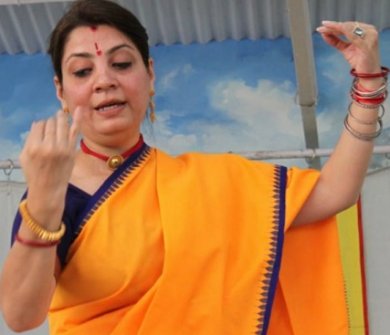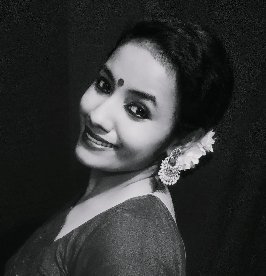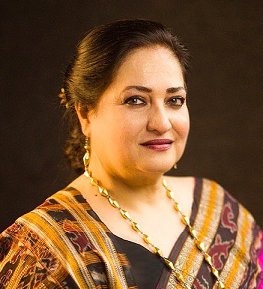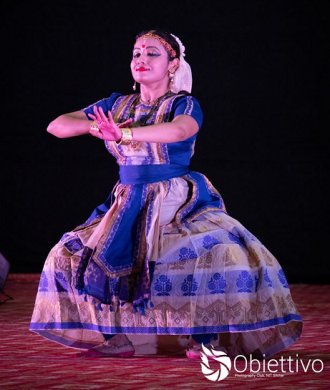
|   |

|   |
 e-mail: leelakaverivenkat@gmail.com Collaborative excellence marks Twelfth Pragjyoti Festival: Part 2 March 21, 2022 Collaborative excellence marks Twelfth Pragjyoti Festival: Part 1  Priti Patel In the session on 'Modern Languages and Literary Studies' in association with Guwahati University, Priti Patel, one of the sought after composers/performers in Manipuri, spoke of working along with television personality and researcher into traditional art, Sadhana Srivastava, who has curated a film (for the SNA) highlighting the perils Manipur's indigenous art forms face in the world of today. Referring to traditional arts fashioned by a people who lived in the lap of nature, who thought of the sounds of the lute as imitating the sound of wind passing through bamboo groves, Priti referred to how raw materials from nature were utilised to fashion an instrument like the Pena (oral teaching) which is like the human voice, tugging at your heart strings with the emotive power of the music produced. Speaking of the Lai Haraoba celebration in the open even today, where the ancient, animistic religion evoking abstract divinity, still very dear to the Meiteis, is restaged - through an elaborate process of awakening divinities existing in the water bodies, by the Maibas and Maibis, worshipping the Mailei Gods impregnated with the spirit of these divinities, and finally lulling them to sleep till the next year - all done to the accompaniment of the Pena. One wonders about the future for now the Pena is becoming a rare instrument. It is the high ritualism which enabled art forms to thrive. Now with rituals compromised, art forms too are in danger. Indie bands have come in and in a politically disturbed state, dance and music as therapy is becoming less. Fearing disturbances and bloodshed at nights, even the Ras Lila in the temples is tied to strict timings to finish before dark. Can the symbolism behind each little danced part of Lai Haraoba, and the subtle nature of how Nature and the soul are linked in a culture, perpetuating that strong inner quest, so much a part of the Manipuri people, survive in an estranged feeling of dancer and clashes in society? What happens to the Pena?  Anwesa Mahanta Anwesa Mahanta's documentation of the Bordhuliya tradition, brought out the interesting point on how villages and interior areas of Assam and also Meghalaya, are resourceful enough to keep alive the old traditions, the continuity flowing from an oral text, where the contemporaneity of the Pauranic culture is established without clashes - with old situations seen as metaphors accommodating the present context. Performed in the fields which become the 'namghar', village artisans help prepare masks, which not only help the development of the plot, but also in establishing the time of the 'Yuga' the tale belongs to and other points. The Jester, aside from the comic role, becomes a social commentator. With a big drum and large cymbals, there is a simple ritual for a smooth performance, and with just the drum and clapping one has the entrance of Yudhisthira, or the dance sequence of Menaka. The 'gayan' composes music too. The humour in communicating this 'living in the moment', the acrobatic element, inscriptions on the masks which are of different types depending on the availability of resources and Gomari wood, with the jester carrying modern messages about Polio (now Covid) vaccine, one has performances responsive to the ecology of time. The discussion on the film on Mrinalini Sarabhai, produced 23 years ago by Nandan Kudhyadi, began with the before- filming issues of research (a time consuming task at any point) being cramped into a specific time availability of the film, and then the challenge of scripting the material to make for an acceptable presentation. Ultimately a biography will be based on the biographer's view of the personality being dealt with, and the aspects of a life and career he selects to highlight. Nandan pinpoints Mrinalini's being sent to Shantiniketan from Kalakshetra, a move which by bringing the dancer directly under a Guru like Tagore, broadened her horizons, leading to her exposure to American drama and theatre too later on. Her marriage to Vikram Sarabhai was a landmark event. The birth of son Kartikeya with his mother watching the child gradually discover his world around resulted in her work Manushya, envisioned in a creative Kathakali style. Her vision of the Contemporary was totally her own - like in Meera where she introduced two Meeras, one the exuberant Meera representing the outer self, for which she cast Mallika and the other the deeply spiritual, inner awakened Meera. She was deeply concerned with environmental problems like the pollution of the Ganga, and her work with the delightfully bubbly springy waters of the young Ganga sent by Shiva to help man on earth with man's insensitive treatment leading to a sullied, sluggish river, rescued by an enraged Shiva, who gathering the now soiled Ganga to his side, turns his back on man. Mrinalini's Ganga was one of the most moving dance creations by her. A poet, she was deeply moved by violence in society, by ill treatment of women, and her use of traditional Bharatanatyam to bring out contemporary societal issues was unique and showed a deeply concerned regard for the future of man. A journey involving spirit and mind, dance for her was delving from body to inner spirit, for people to discover their own selves. It became a mirror in which one saw the truth. Hence her institution was named Darpana. "I work on bodies as with clay - my choreography is not systematic, but instinctive. I work as a painter does with colours - my creations can change - very malleable." The filmmaker thinks of her as a pathfinder who discovered new ways of using traditional dance forms like Bharatanatyam and Kathakali. ARTS AND THE LAW  Arshiya Sethi The session on Arts and the Law, conceived and presented by Dr. Arshiya Sethi under Kri, in association with the Law College at Guwahati, was one of the highlights of Pragjyoti festival. Arshiya Sethi's multi-dimensional interests, have spurred action, what with Kri's motto of helping society through arts in an 'Arts, Activism and Knowledge' triangle. Dean of the Law College, Mr. Bhupen Baruah began with a statement that 'Rules of Law should be rules of life'. He mentioned that the 'Pandemic however marked a turning point in human Law', and Law now had entered every aspect of life from climate change to art. Arshiya began her illustrated talk- her lucid exposition more like a lawyer's - with the statement that artistes are people who dealt with creating 'rasa,' the wholeness of an experience. As an art activist, she was taken aback by the High Court orders in the M.F. Hussein case. Yet another shocking judgement, quite deplorable, concerned a rape case, wherein the judge seemed totally ignorant of the rape law. She came across constantly occurring problems of copyright, of plagiarism, and of artistes who were running their own small institutions, suddenly faced with the crisis of unfulfilled contractual obligations, with what had been regular government grants suddenly drying up. Another frequent occurrence distressing her pertained to cases of sexual problems confronting girls and women learning under Gurus. She also saw problems arising out of artistes on airline travel to outside places to perform, when confronted with manhandled, damaged or lost musical instruments during travel (with the compensation in normal airline laws not meeting even a fraction of the expense involved in buying an instrument). Several such experiences made Arshiya feel that Arts needed to be served by special laws along with informed lawyers who could ensure a measure of help to artistes caught in such circumstances. She also touched on other tricky areas in the art world of non-legal personal accounts, of artistes with a total absence of consciousness about copyright, of having to contend with shooting and morphing of pictures. The rights of special communities involved in art work, she also found, were disregarded. Children were made to work long hours without rest. Such instances and many more made her start her website unmute.help - a one point organic portal for arts and the law, not as a smuts column as some think, but to spread greater awareness of where the artist stands. Coming across cases of child abuse has made her closely study laws dealing with child artistes with disabilities facing trauma, with the Beggary Act, and also looking at cases of old jugglers who find no employment etc That most of these are covered under the POCSO Act (Protection of Children from Sexual Offences) and that our country has one of the strongest POCSO acts, is largely unknown. Children particularly, she felt, had to be informed about these pitfalls and safeguards that law provided. And she also said that people dealing with child artistes and youngsters had to be inspected and tested every year. She spoke of the abuse of differently abled artists, which constituted a double problem. And here again in India, awareness is lacking. Cyber crimes increased greatly during the pandemic. Unfortunately, victims are hesitant to go to the authorities to complain. Lots of areas require better laws like the treatment of Hijras for instance, a group wrongly clubbed with the criminal Tribes Act of 1871 - fortunately later removed, but still under an extra criminal law. In the dance community, the stylization of women Devadasis as performing women in a sub eco system seemed to put them outside the pale of the country's legal system. With Muthulakshmi Reddy pushing the Devadasi Prevention Act, came the death knell of the entire institution, also resulting in the country losing a great deal of intangible heritage in art. The males as Nattuvanars flourished, while the female performers got punished. With the Guru Shishya Parampara, the hierarchy of relationship made the shishya absolutely powerless. When the Guru determines the student's pathway and career, the whole process is open to favouritism. As for whispering campaigns about sexual exploitation, and the recent Me Too finger pointing, Arshiya feels that the silence of enablers who, in many cases were complicit, and students from more influential sections who were treated differently and who did not speak up for their less fortunate colleagues, was unforgivable. It is precisely because arts are not easy to categorise that Law and the Arts must work in a jugalbandi to strengthen the system. The trouble is that classical dance cannot be treated as any other standardised product. And yet when classical dance which is lionised and prioritized will be staged at government houses and on posh stages, while the folk artiste even on Republic Day will dance in the parade, one has to ask questions. Arshiya also questioned the Sedition Law, wondering what the parameters of sedition were - as when a Hasya Rasa comedian like Munawar Faruqui was booked under Indian penal code. Then there is the Blasphemy Law brought into being during the British rule, which also needs to be looked at again. In 1876, the British brought in the Dramatic Performance Act to control theatre. One has to know that traditional art like Bhaonas staged in Assam, were anti colonial, as a great deal of theatre has been a protest, strongly critical of what is considered unethical. How does one function by accommodating these sentiments, in a democratic society? Arshiya also wondered whether a Guru whose knowledge has come from another Guru, can claim copyright for what he teaches. In the West, she said that there are cases when even rhythms are appropriated. The non privileged communities engaged in crafts work suffer more, for violations come mostly from privileged communities. How does one deal with these issues? And finally is the crucial questioning and prescribing the limits of freedom of expression. Is this right unrestrained? Protest is fine, as long as it does not threaten the fabric of society. Where does one draw the line? There has to be a lot more discussion and writing on these points. While we can claim that the urgency of expression in an artiste cannot be denied, one has to understand what its limits are. The speaker was touching on sensitive areas. When a caricature of the prophet can cause a riot, one needs to remember that in a plural society where many religious groups live together, one has to be careful of not causing disruptions, through what one may otherwise feel a free society is entitled to. Ultimately there are no rights which are unlimited. As Arshiya Sethi concluded, the need of the hour is for all round awareness and discussions. Informed lawyers is one thing, but how many in the artiste community are able to afford these lawyers for fighting cases in court is another question. The manner in which the speaker was bombarded with queries, highlighted the need for spreading awareness in this department. HIGHLIGHTS ON SATTRIYA Held in association with the Department of Modern Indian Languages and Literary Studies, Guwahati, the session devoted to questions and answers on the special features of the Sattriya tradition, moderated by Aranyani, with Mahalakshmi's queries, was most informative for dance lovers outside the Sattriya fold. Asked about the dance tradition and its link with the Sattras in Assam, Dr. Arshiya Sethi answered that Sattriya is the only example of a tradition presenting an unbroken 500 year spectrum, with the monastic tradition in which it was conceived and practised still thriving along with its performance avatar on the 20th century proscenium space. In all other dance traditions like Bharatanatyam, the temple tradition had ceased to exist when the proscenium form began to take shape. Part of the larger religious / cultural resurgence of music, theatre and painting during the neo Vaishnavite movement propagated in Assam by the great religious teacher Sankaradeva (1449-1568), a poet, musician, playwright and religious teacher, Sattriya was a movement, its celebration of thought, both mind and body combining the deeply spiritual with the performative. This 500 year history has its memory only in the living body for its technique is not prescribed in any ancient text like the Natya Sastra. It has no links in sculpture and no regional texts either on its technique in Assamese or in Brajbhasha or in Sanskrit (except for some hand gestures common to what is mentioned in Srihastamuktavali). Its history is to be found only in the Sattras, Sattriya's sole guardian and practitioner down the ages. The term Sattriya, referring to a total theatre tradition in the Sattras called Ankia Bhaona, the dance carrying the same name is one part of it. The monastic system was established by Sankardev's disciple Madhav Dev and these monks, as Arshiya pointed out, while exclusive were not isolated and interacted with society. The aspect of the dance, though very old, was recognised as 'classical' only when Dr. Bhupen Hazarika presided over the SNA as its head. So to quote Arshiya, "Sattriya dance has a birthday, 15th March 2000" (when recognition was given) 'living in two different cartographies' of the Sattra and of the proscenium.  Anwesa Mahanta Dancer/scholar Anwesa Mahanta described how Ankia Bhaona as total theatre comprised dance as a very important part, along with music, crafts, weaving (Vrindavani Vastra woven in the 16th century by Mathuradas Burha, a disciple of Sankaradev), mask making and painting - all part of Sattriya. Open to all castes and communities, its secular approach, its simplicity and lack of ritual, made Sattriya sought after. Answering the query of why she had researched on the politics of Sattriya, Arshiya pointed out that Sattriya actually started as a resistance movement to the existing Ahom society, its entire open approach totally opposed to the caste hierarchy of the time. Situated geographically on the borders of India, Assam's large floating immigrant population had led to endemic problems of labour, land and law still dogging the State. Right from the fifties, Assam as the blind spot for central agencies in India, had had to deal with these difficult areas of foreigners, of resources being taken away and of 'Assamese culture being endangered' without the Indian government addressing these problems. With balkanisation of Assam with parts going away to Meghalaya formed in 1949, parts to Manipur (getting its full statehood in 1972), and much earlier to Nagaland in 1963, what with the ALFA secession and the quick succession of the first Chinese aggression, resulted in the Assam agitation of 1979. The Assam Accord signed in 1985 was an appeasement of Assamese sentiments "to promote cultural, social, linguistic identity and heritage of Assam" which in a way helped the recognition of Sattriya as a classical tradition in 2000. As pointed out by Anwesa Mahanta, it is important to remember that it was the Sattra that began teaching women (Raseswar Saikia Borbayan was made to leave the Sattra because of this), and later many of her family members like Professor Mahanta, and her own Adhyapak Ghanakanta Bora Borbayan, worked very hard to create a format for stage presentation of Sattriya, for context was important and what was presented as ritual in the Sattra, could not be copied for a different space like the proscenium. Scholars like Maheswar Neog (1915-1995), Jagannath Mahanta, and later dancers like Sharodi Saikia, Indira P.P.Bora, Maniram Dutta Muktiyar of the Kamalabari Sattra, Dr. Bhupen Hazarika helped create an awareness about Sattriya while keeping in mind the fact that prayer and performance, while different in purpose, had to retain the Assamese identity. The interpretative texts for a cosmopolitan audience could present new ideas and to make the purely bhakti oriented into a performance has had its challenges, which Sattriya is manfully dealing with.  Writing on the dance scene for the last forty years, Leela Venkataraman's incisive comments on performances of all dance forms, participation in dance discussions both in India and abroad, and as a regular contributor to Hindu Friday Review, journals like Sruti and Nartanam, makes her voice respected for its balanced critiquing. She is the author of several books like Indian Classical dance: Tradition in Transition, Classical Dance in India and Indian Classical dance: The Renaissance and Beyond. Post your comments Pl provide your name and email id along with your comment. All appropriate comments posted with name and email id in the blog will also be featured in the site. |